From tiny hitchhikers in your bait bucket to massive predators in your waterways, these 25 invaders have upended habitats across the United States.
Learn where they came from, how they snuck (or were released) into American ecosystems, where they’re thriving now, and proven tactics to keep them at bay.
1. Zebra Mussels (Dreissena polymorph)
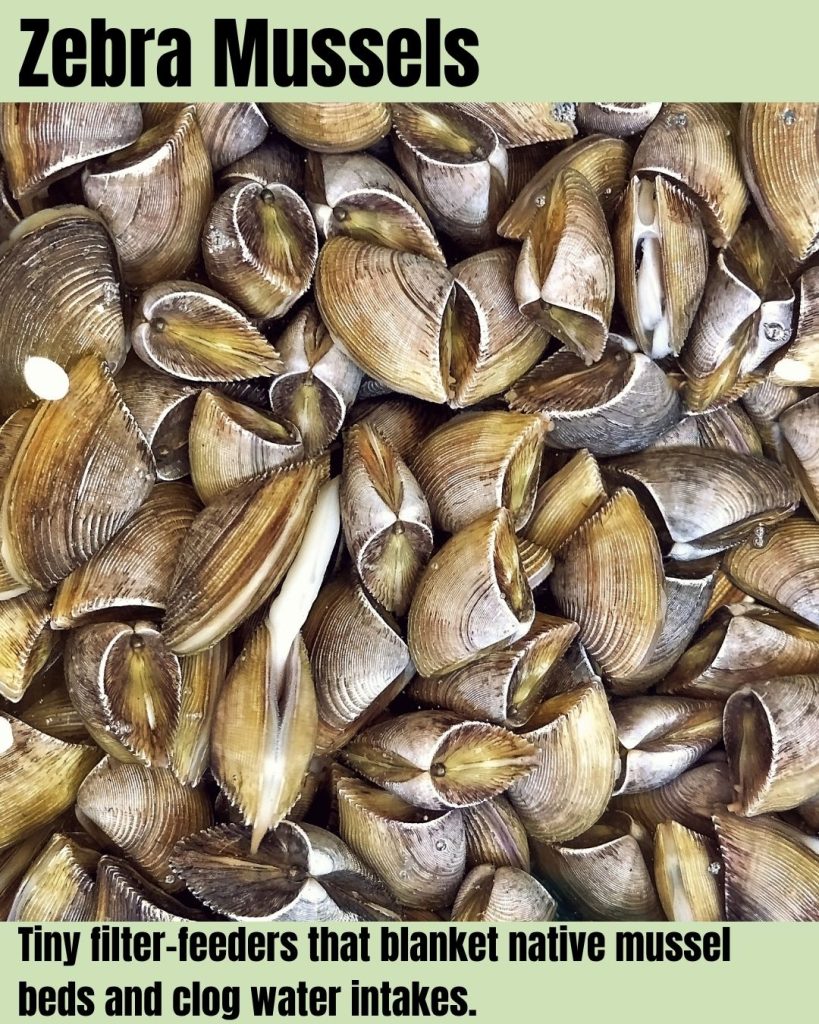
- Can filter up to a liter of water per day, literally clearing your lake!
- Hitchhikes on boat hulls and trailers, surviving days out of water.
- Colonies can add weight that sinks docks and clogs pipes.
Native to Eastern Europe and Western Asia, zebra mussels arrived in the late 1980s in ballast water discharged into the Great Lakes.
They clog intake pipes, smother native mussels, and alter food webs across 30 states; control involves mandatory boat inspections, decontamination stations, and molluscicide treatments in closed systems.
2. Quagga Mussels (Dreissena bugensis)
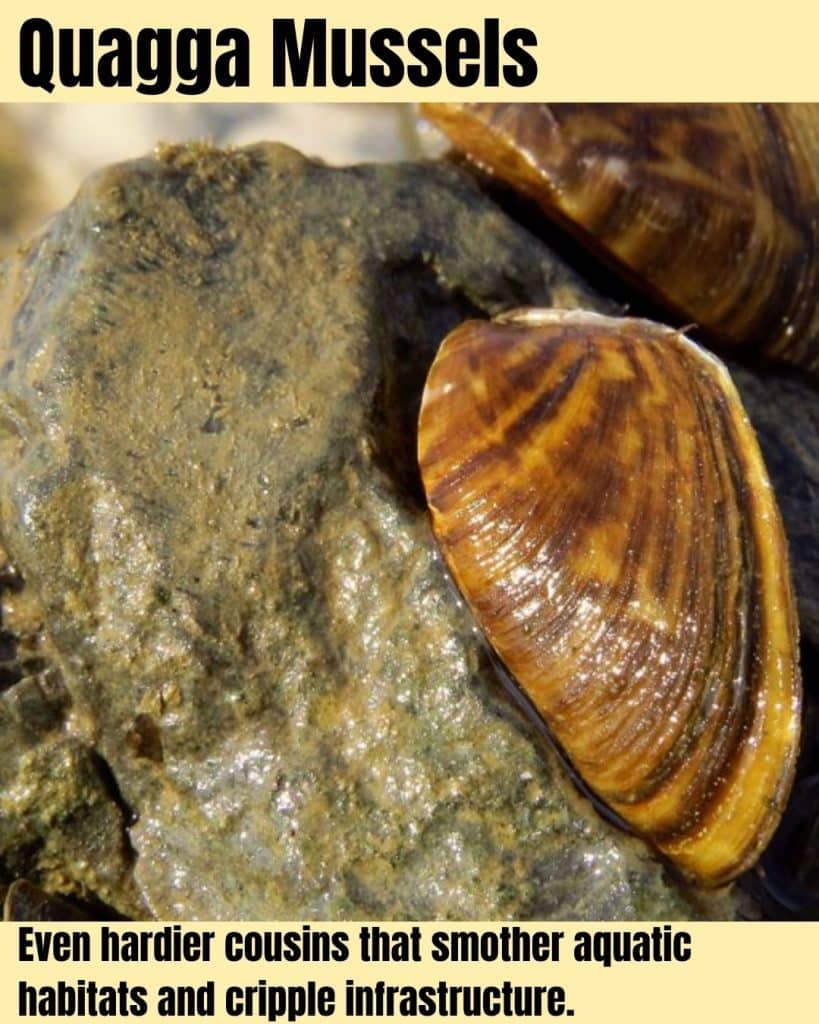
- Thrives in colder, deeper water zones where zebra mussels can’t.
- Can survive on sand and mud without attaching: more spread power!
- Filters plankton so efficiently that it turns clear lakes into algae deserts.
Hailing from the Dnieper River drainage in Eastern Europe, quagga mussels came over via the same ballast-water pathway in the late 1980s.
They tolerate colder, deeper waters than zebra mussels, fouling power-plant intakes and competing with native invertebrates throughout the Great Lakes and the West; management mirrors zebra mussels with inspections, decontamination, and targeted chemical treatments.
3. Asian Carp (Silver, Bighead & Grass Carp)

- Silver carp can launch 10-foot airborne somersaults when startled by boat motors.
- Bighead carp gobble up 20% of their body weight in plankton daily.
- Capable of producing over a million eggs per season, talk about reproductive overkill.
Originating in East Asia, these carp were imported in the 1970s for aquaculture and vegetation control, then escaped into the Mississippi Basin during flooding.
They devour massive amounts of plankton, which starve out native fish.
And now they threaten river ecosystems from the Gulf Coast up toward the Great Lakes. Control relies on electric barriers, targeted commercial harvesting, and experimental pheromone traps.
4. Northern Snakehead (Channa argus)
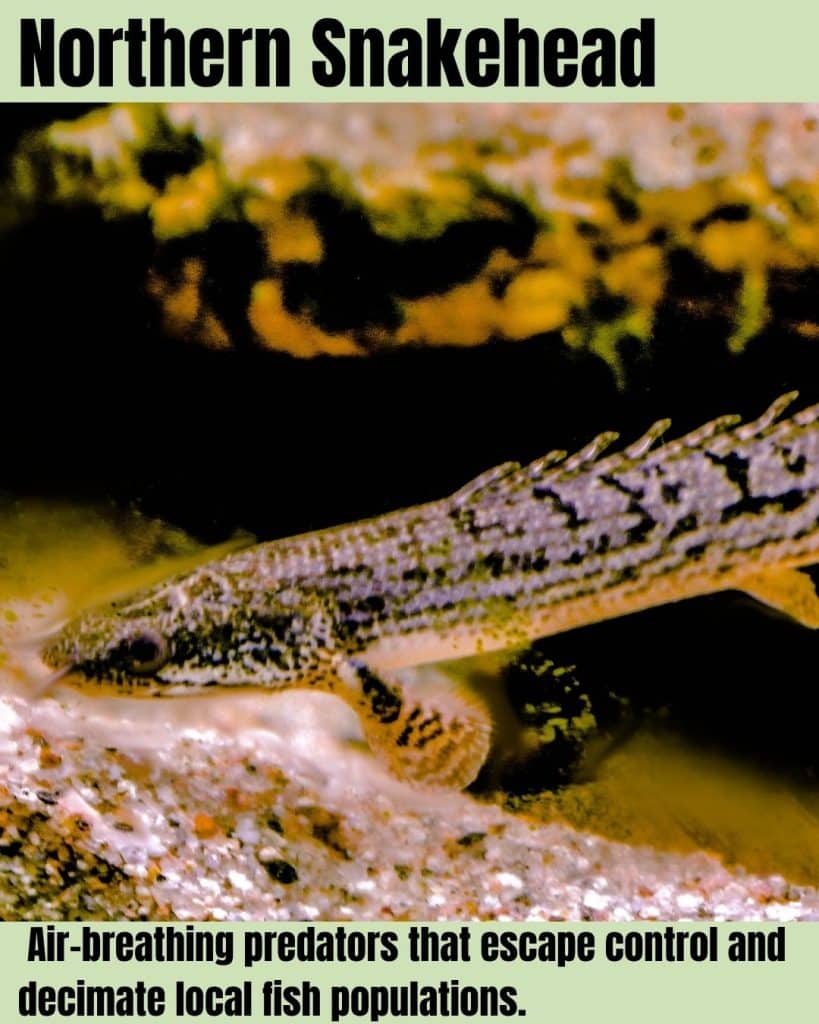
- Breathes air and can slither across land up to 100 feet to colonize new ponds.
- Eats almost anything- fish, frogs, even small birds; making it a top-tier predator.
- Can survive in muddy puddles for days, waiting for water to return.
Native to China and Russia, northern snakeheads showed up in a Maryland pond in 2002 after aquarium releases.
Their ability to breathe air and wriggle over land lets them colonize waterways in the Chesapeake Bay region and beyond, where they prey on native fish and amphibians.
Control focuses on rapid‐response removal, public reporting, and strict regulations on possession.
5. Burmese Python (Python bivittatus)
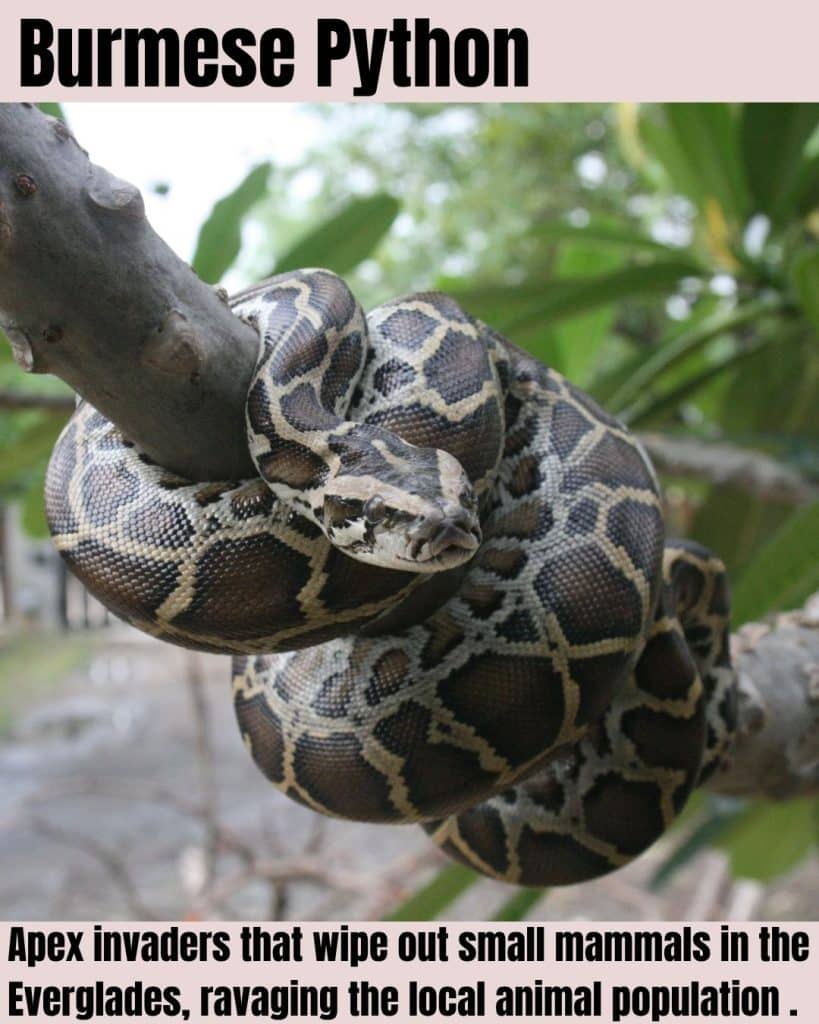
- Unhinges its jaw to swallow prey as big as alligators.
- Can go six months between meals thanks to a super-slow metabolism.
- Females lay up to 100 eggs at a time in hidden nests.
These giant constrictors from Southeast Asia escaped or were released from the pet trade in South Florida in the early 2000s.
Roaming the Everglades, they prey on mammals, birds, and reptiles, causing dramatic declines in small mammal populations.
Controlling them comes in the form of organized removal hunts, detection dogs, and public “Python Challenge” events.
6. Lionfish (Pterois volitans)
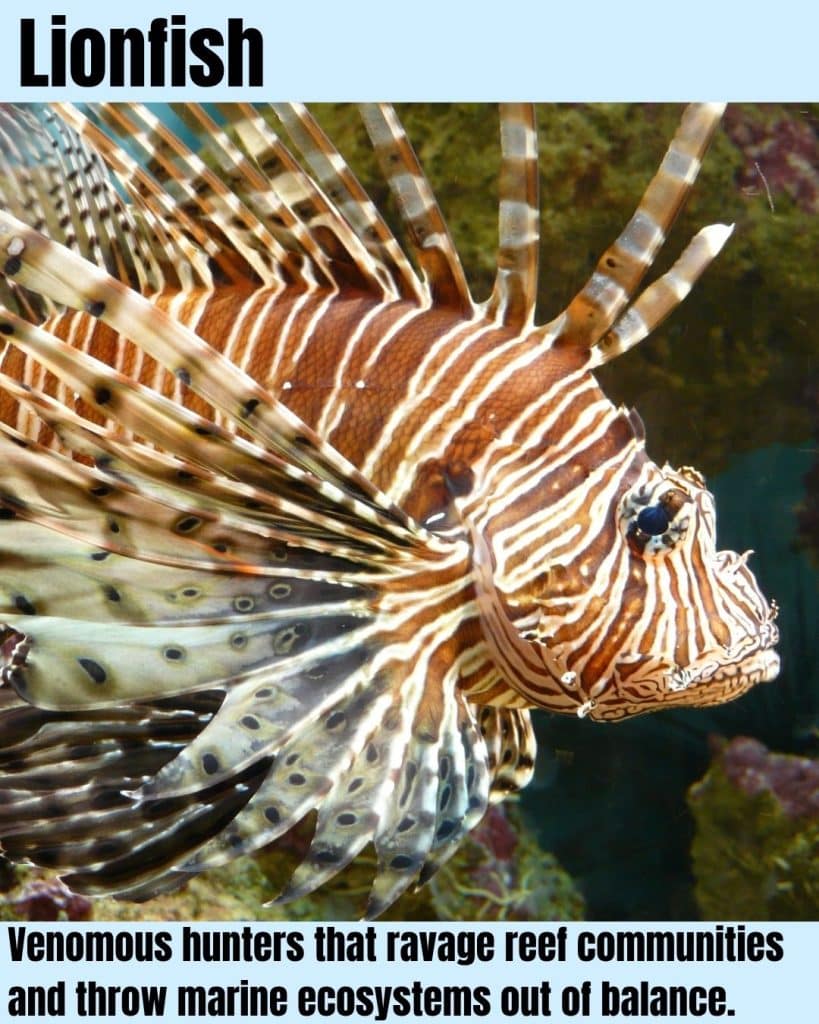
- Sprays venomous spines with enough power to penetrate wetsuits.
- Reaches sexual maturity in just one year and breeds every four days.
- Has no native predators, so populations explode unchecked.
Native to the Indo-Pacific, lionfish likely entered Atlantic waters through aquarium releases in the 1980s.
They’ve spread from Florida to North Carolina and throughout the Caribbean, voraciously eating juvenile reef fish and stressing coral ecosystems.
Control strategies include spear-fishing derbies, training divers to remove them, and even promoting lionfish as a tasty seafood option.
7. Feral Hog (Sus scrofa)
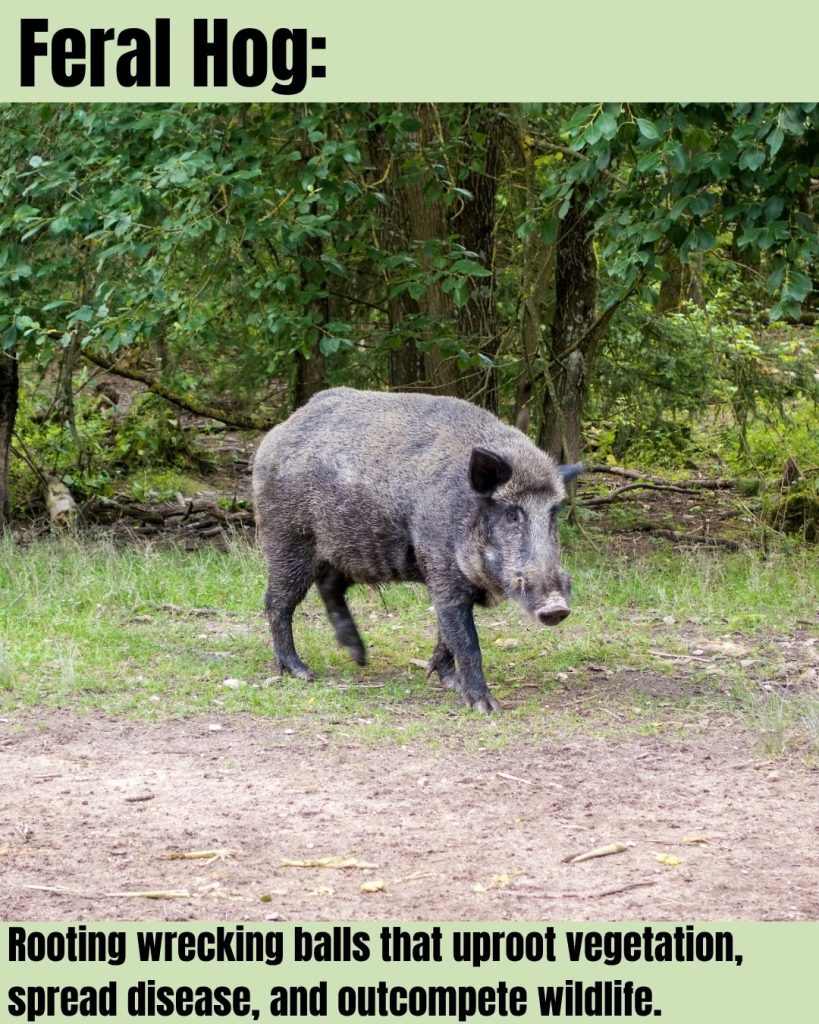
Can run up to 30 mph, faster than an NFL wide receiver.
Sniffs out roots and tubers up to two feet underground.
Roots and wallows can turn a pristine meadow into a mud pit.
Descended from escaped domestic pigs and Eurasian wild boar introduced by European settlers in the 1500s, feral hogs now roam freely in 35 states.
Their rooting behavior uproots vegetation, spreads disease, and preys on ground-nesting wildlife.
They are thought to control. The best methods rely on trapping, aerial or ground shooting, and exclusion fencing around high-value areas.
8. Nutria (Myocastor coypus)
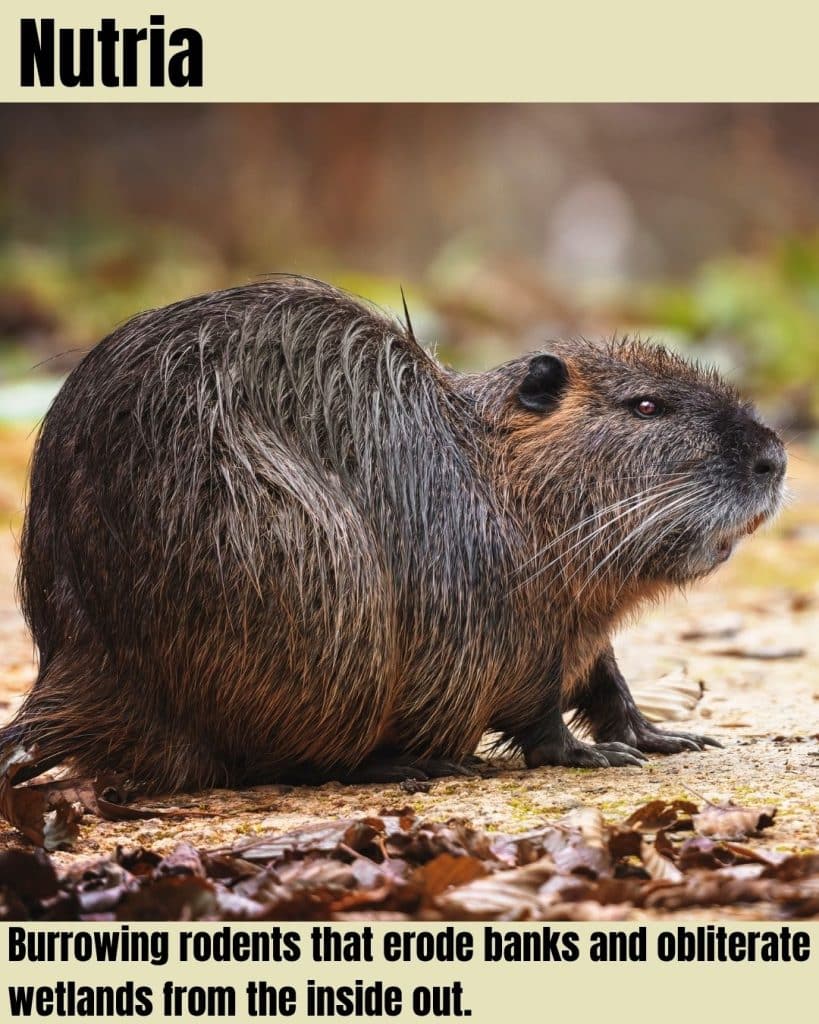
- Front teeth grow orange like carrots; nature’s own warning sign!
- Can hold their breath underwater for up to five minutes.
- Produce two litters of up to 13 pups each year, all wetland wreckers.
This large rodent from South America was brought to the U.S. for fur farming in the early 1900s and escaped into wetlands along the Gulf Coast and Pacific Northwest.
Nutria burrow into levees and riverbanks, causing erosion and wetland loss.
Effective control includes targeted trapping, coordinated eradication programs, and habitat modification to reduce cover.
9. Feral Cat (Felis catus)

- Estimated to kill billions of birds annually in the U.S. alone.
- Can squeeze through gaps as small as 3 inches wide.
- Pay attention: they’re crepuscular hunters, which means they’re most active at dawn and dusk.
Domestic cats brought by European colonists became feral when abandoned or permitted to roam; today, free-roaming cats form colonies nationwide.
As skilled hunters, they kill billions of birds, mammals, and reptiles each year.
They’re tough to deal with. Management combines trap-neuter-return (TNR) programs, public education on indoor cat care, and targeted removal in sensitive habitats.
10. European Starling (Sturnus vulgaris)
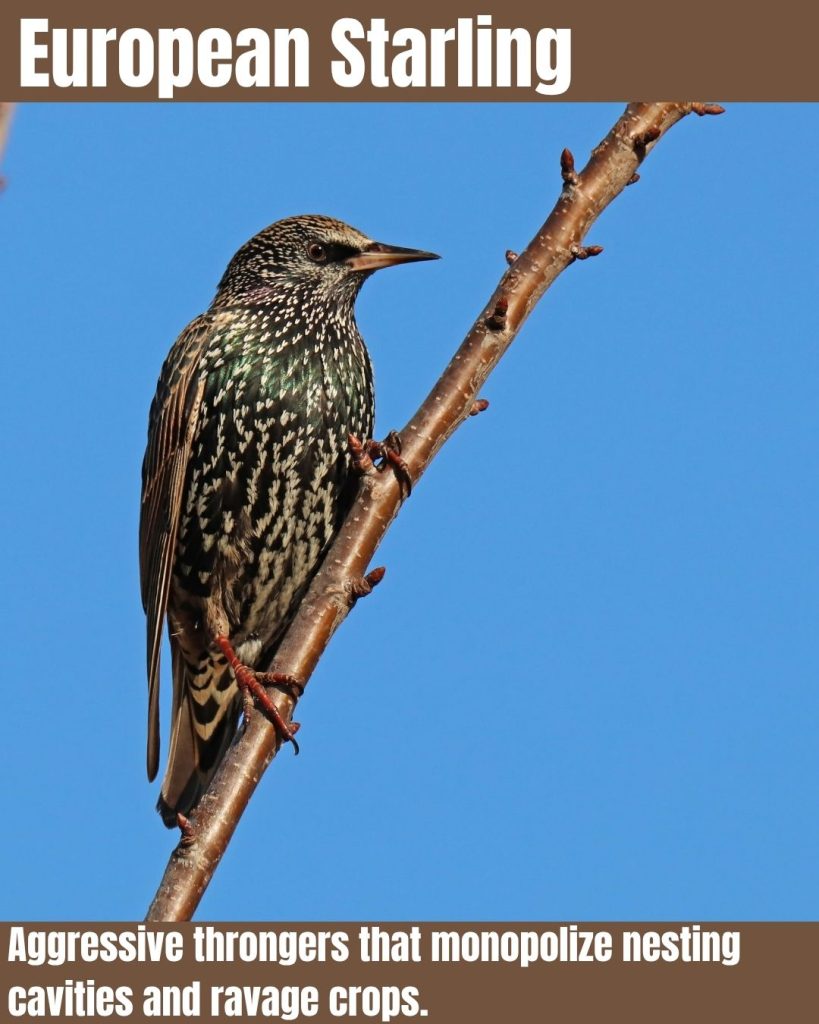
- Forms flocks of millions, creating murmurations that can darken the sky.
- Superb mimics, they can imitate car alarms, human voices, and other birds.
- Competes for nest cavities by evicting native chicks mid-flight.
Released deliberately in New York’s Central Park in the 1890s by Shakespeare enthusiasts, European starlings now number over 200 million across North America.
They outcompete native cavity-nesting birds and damage crops and livestock feed.
Control tactics include nest‐box exclusion, avian repellents, and limited trapping or shooting on agricultural land.
11. House Sparrow (Passer domesticus)
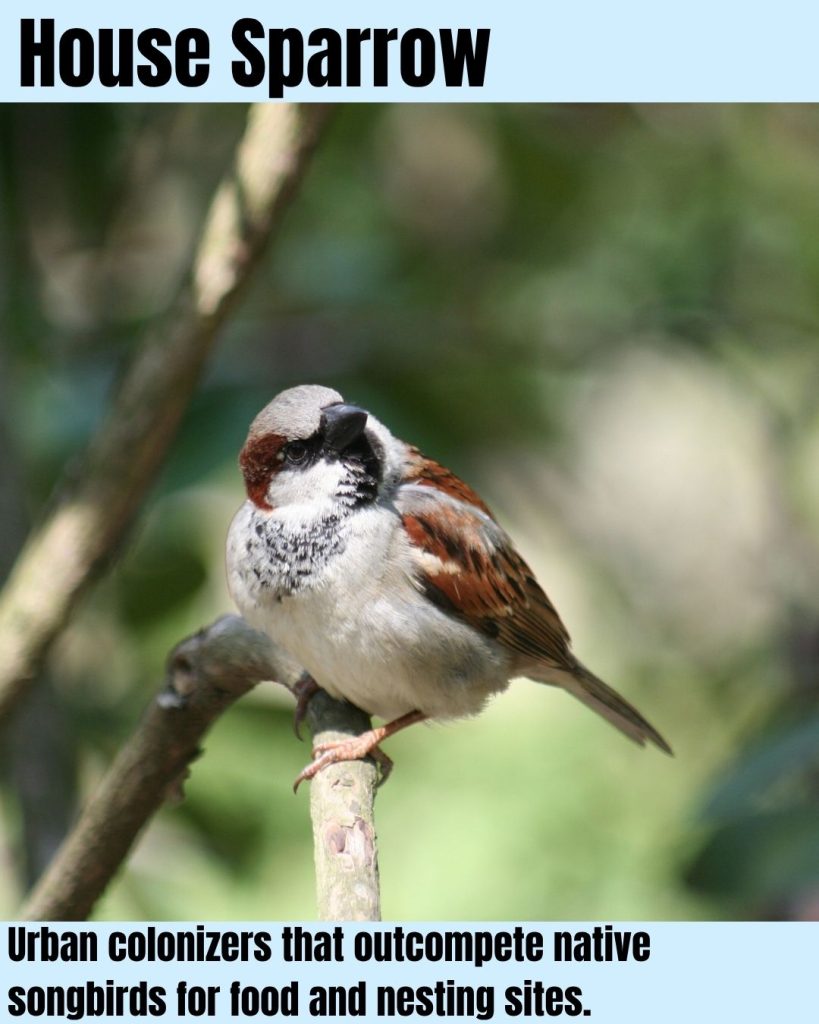
- Built to thrive around humans: nests in eaves, vents, and light fixtures.
- Eats almost anything: seeds, scraps, insects; making it a versatile pest.
- Aggressively chases native songbirds from feeders and nesting spots.
Introduced in the 19th century for familiar songbird charm, house sparrows now thrive around human habitation from coast to coast.
They compete with native songbirds for nesting sites and food; control consists of nest removal, exclusion devices on buildings, and reducing spilled birdseed.
12. Red Imported Fire Ant (Solenopsis invicta)
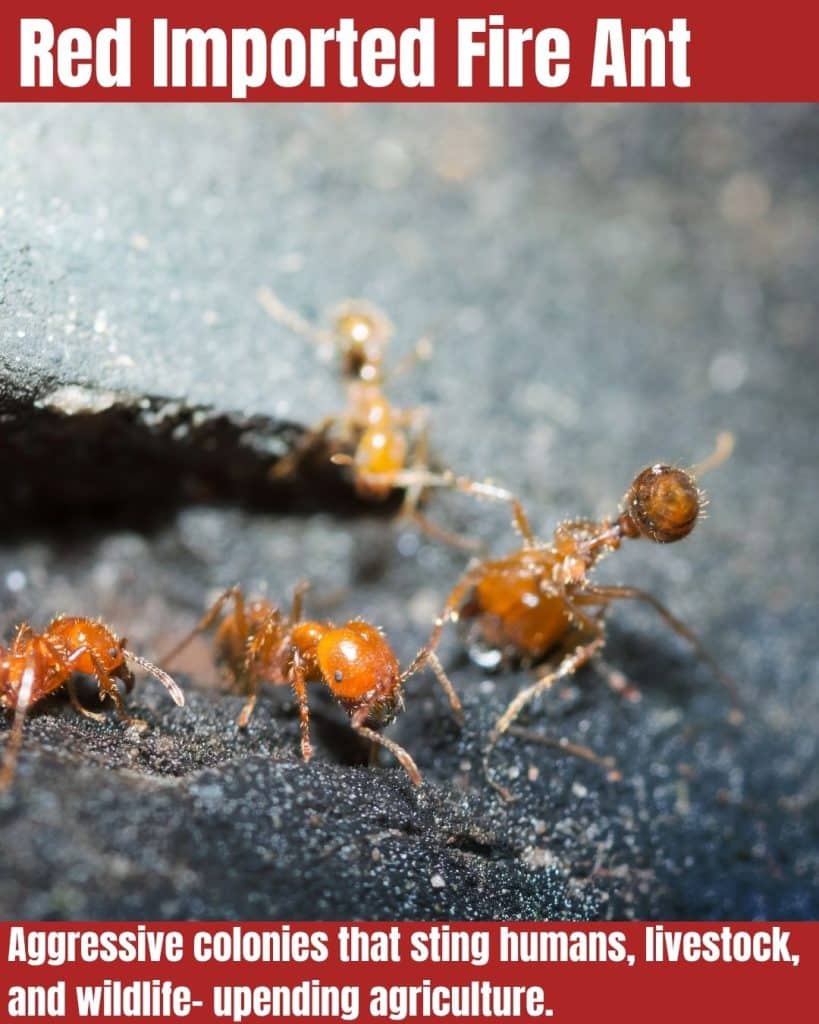
- Colonies can house up to 250,000 workers with multiple queens.
- Mounds can “flood” themselves by linking together into living rafts.
- Known to enslave other ant species by stealing larvae.
Accidentally brought in shipping materials from South America to Alabama in the 1930s, fire ants have since spread over 300 million acres of the Southeast.
Their aggressive colonies inflict painful stings on humans and livestock and damage crops.
Control uses slow-acting baits, mound drenches, and biological agents like parasitic flies.
13. Argentine Ant (Linepithema humile)
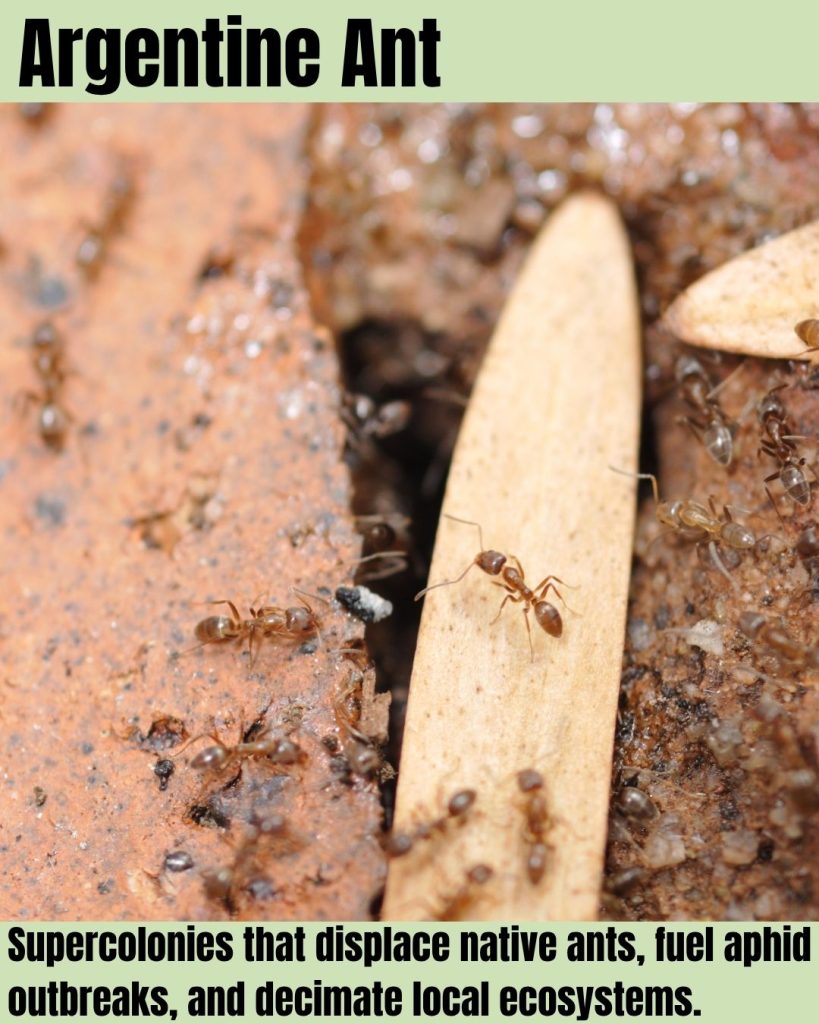
- Forms supercolonies spanning hundreds of miles along the California coast.
- Display almost zero aggression toward nestmates: It’s a united global takeover.
- Tend aphids for honeydew, turning farms into ant-infested sugar plantations.
This South American species arrived in the U.S. in the 1890s via cargo shipments and now dominates urban and agricultural settings in California, the Southeast, and the Gulf Coast.
Argentine ants displace native ant communities, disrupt pollination, and tend aphids that harm crops; control focuses on bait stations with insect growth regulators and habitat changes to reduce moisture.
14. Africanized Honey Bee (Apis mellifera scutellata)
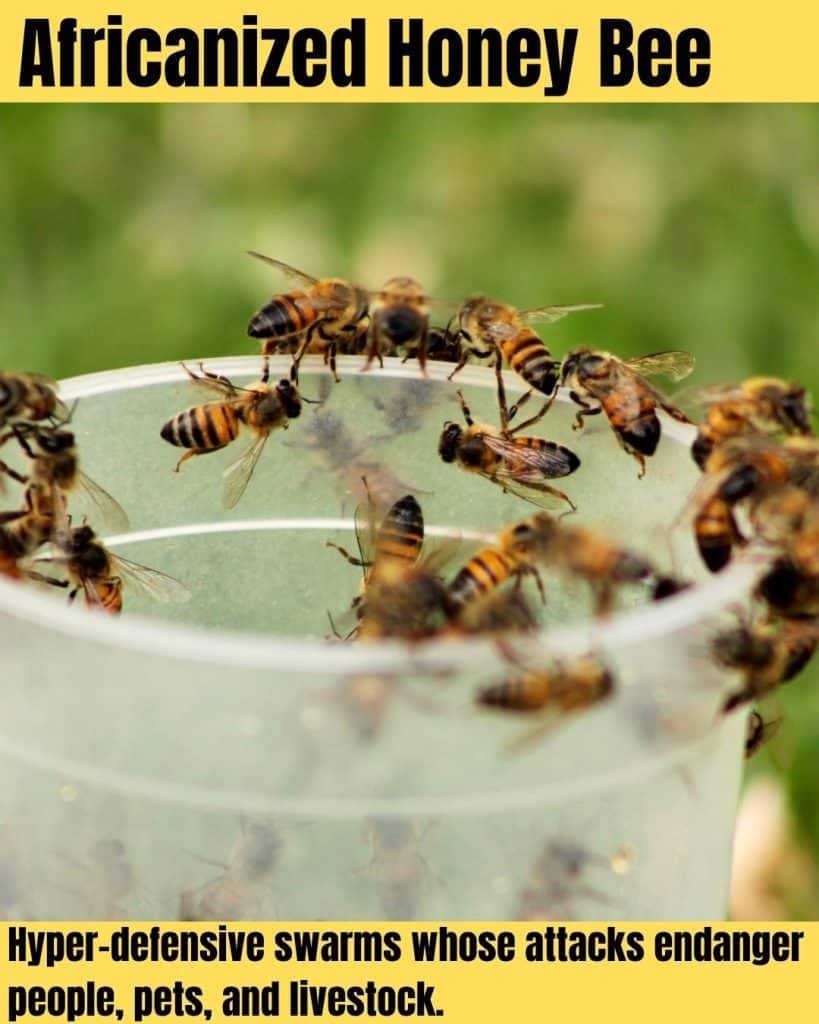
- Defend hives with up to 100 times more stings than European bees.
- Can chase perceived threats up to 400 yards- no place to hide!
- Swarm relocations can involve up to 10,000 bees traveling miles together.
Hybrid bees from Africa were released in Brazil in the 1950s and spread north, reaching the U.S. border by the 1990s.
Dubbed “killer bees” for their intense defensive behavior, they pose risks to humans and livestock. Management involves hive removal by professionals, public awareness, and the use of protective gear.
15. Asian Tiger Mosquito (Aedes albopictus)
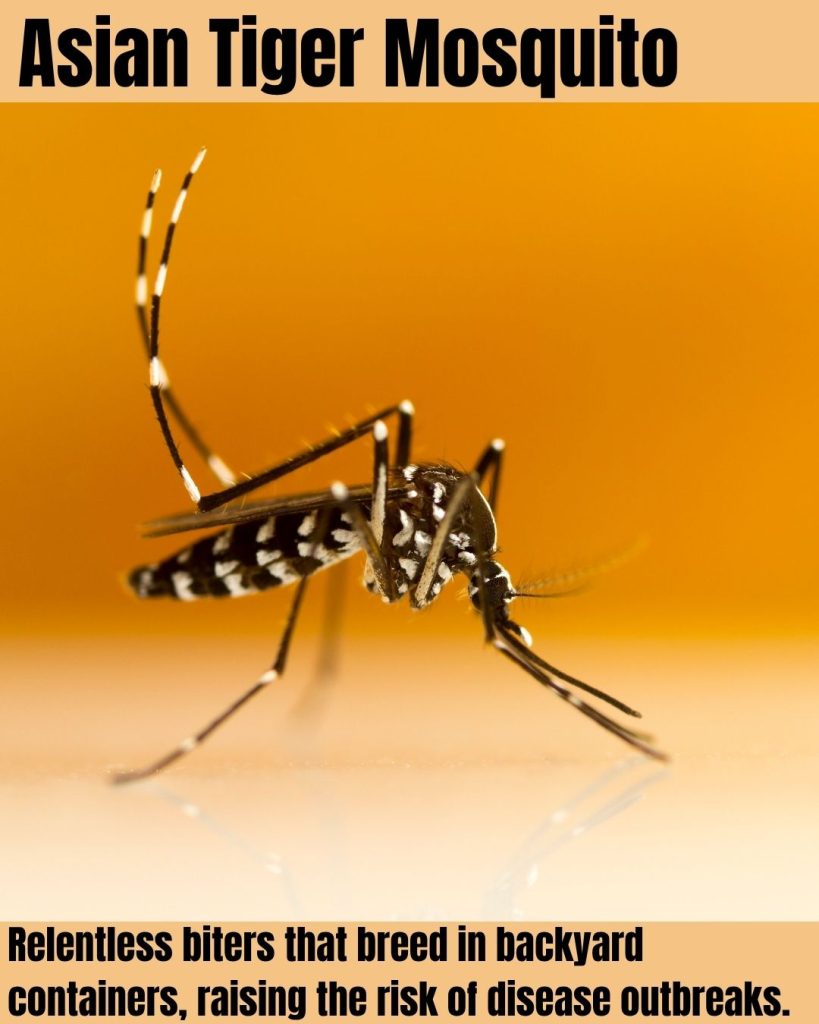
- Stripes aren’t just flashy, they warn predators of their toxicity.
- Eggs can survive through winters and hatch when the waters return.
- Aggressive daytime biter with a taste for human blood and disease.
Native to Southeast Asia, tiger mosquitoes arrived in the mid-1980s via used-tire shipments.
They breed in urban containers, bite aggressively, and can transmit chikungunya, dengue, and Zika viruses.
Control measures include removing standing water, larvicides in drains, and targeted adulticide spraying.
16. Japanese Beetle (Popillia japonica)
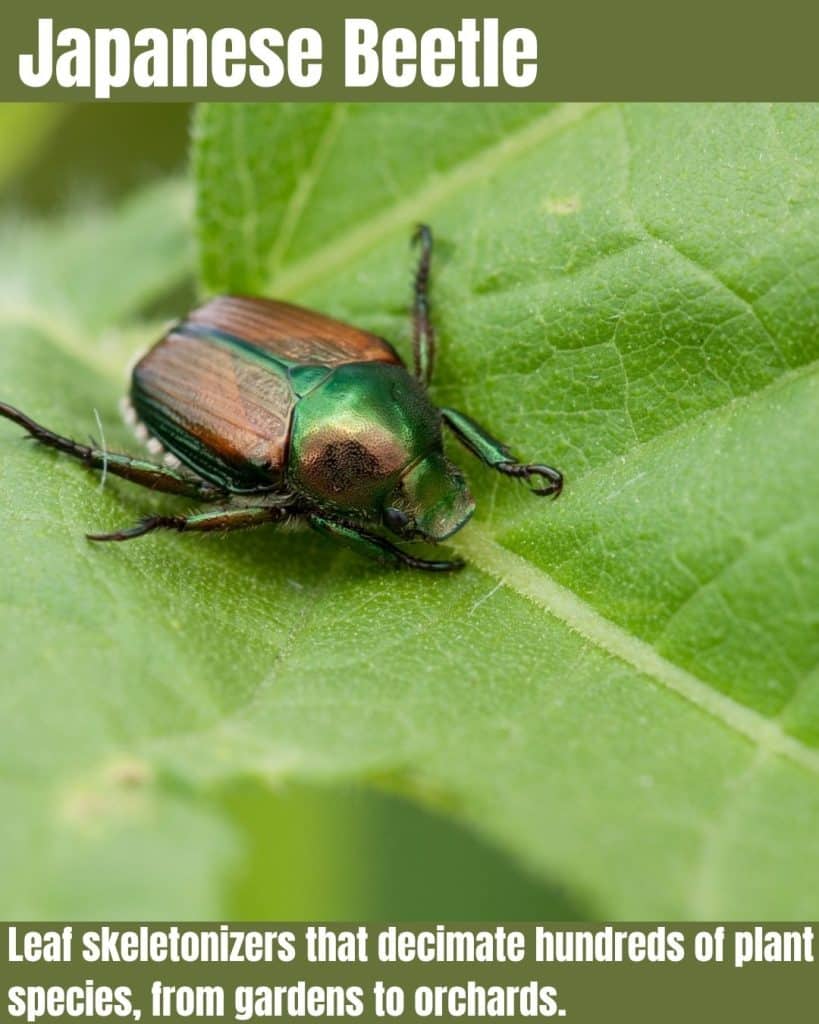
- Larvae (grubs) can spend up to three years munching turf roots underground.
- Adults love rose petals so much they skeletonize entire blooms overnight.
- Attracted to UV light traps, just don’t let them escape afterward!
Escaping ornamental plant imports from Japan in the early 1900s, these beetles now skeletonize leaves of over 300 plant species in the Eastern U.S.
Turfgrass grubs also damage lawns; control combines pheromone-baited traps, soil insecticides for grubs, and microbial biocontrols like Milky Spore.
17. Emerald Ash Borer (Agrilus planipennis)
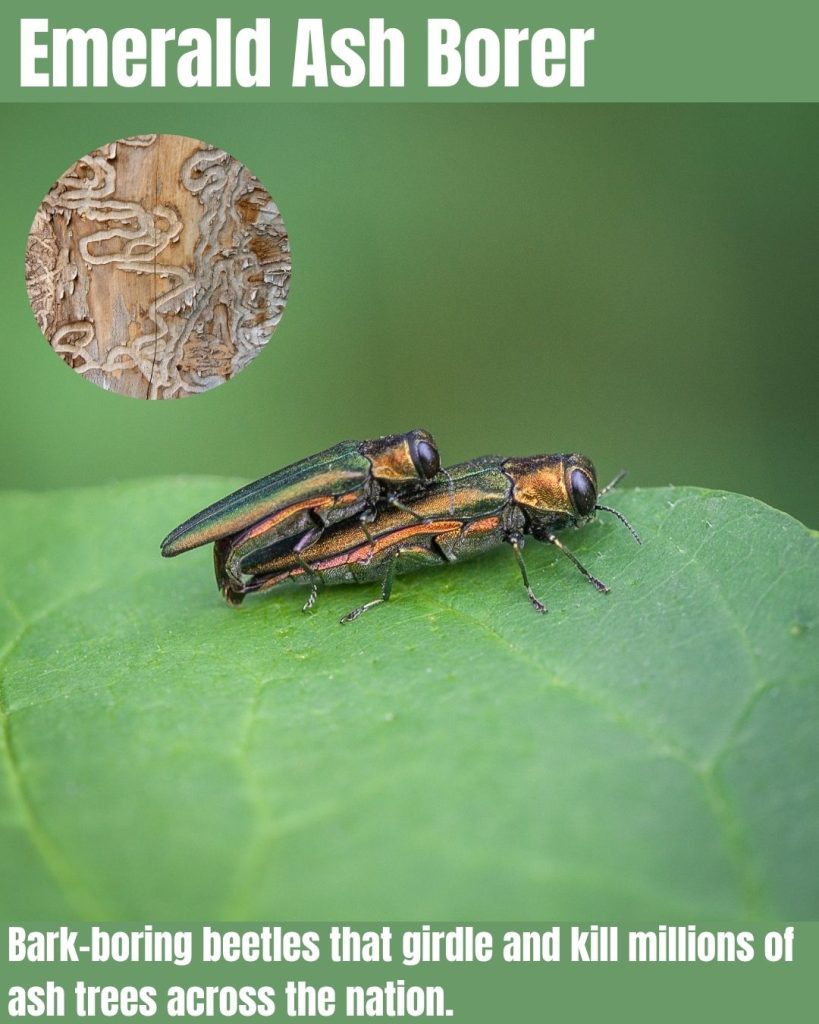
- Shiny metallic green adults are only alive for 3-6 weeks each summer.
- Can detect ash trees from half a mile away using scent cues.
- Larval galleries under bark look like stacked pancakes-tree-killing art.
Native to Northeast Asia, emerald ash borers were detected in Michigan in 2002 after arriving in wood packing material.
Larvae tunnel under ash bark, girdling trees and killing them across 30+ states; control uses quarantines on firewood, biological control via parasitic wasps, and systemic insecticide injections in high‐value trees.
18. Asian Longhorned Beetle (Anoplophora glabripennis)
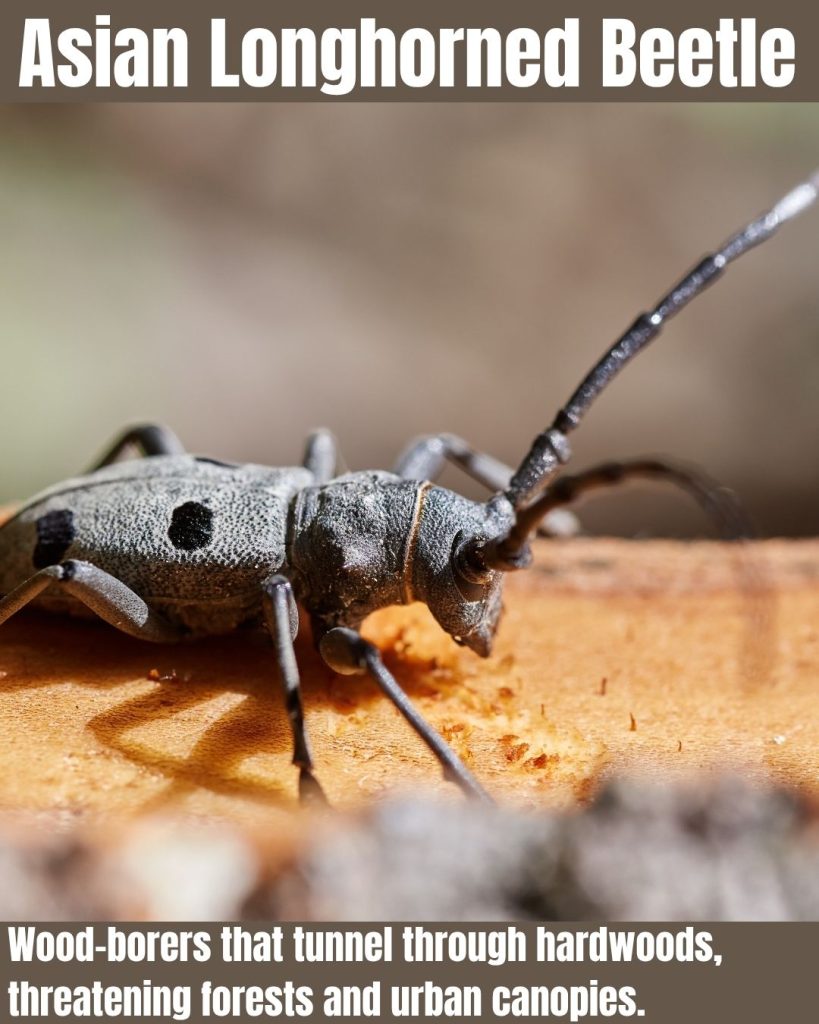
- Can chew through hardwood like plywood, weakening trees from the inside out.
- Long antennae can exceed their body length, perfect for sensing hosts.
- The larval stage lasts over a year, consuming tons of wood before emerging.
Arriving on wood packing crates from China and Korea in the 1990s, these beetles infest hardwoods in New York, Illinois, Massachusetts, and Ohio.
Larval tunneling weakens and eventually kills maples, elms, and other shade trees.
Eradication includes felling and chipping infested trees, strict wood disposal rules, and intensive survey efforts.
19. Spotted Lanternfly (Lycorma delicatula)
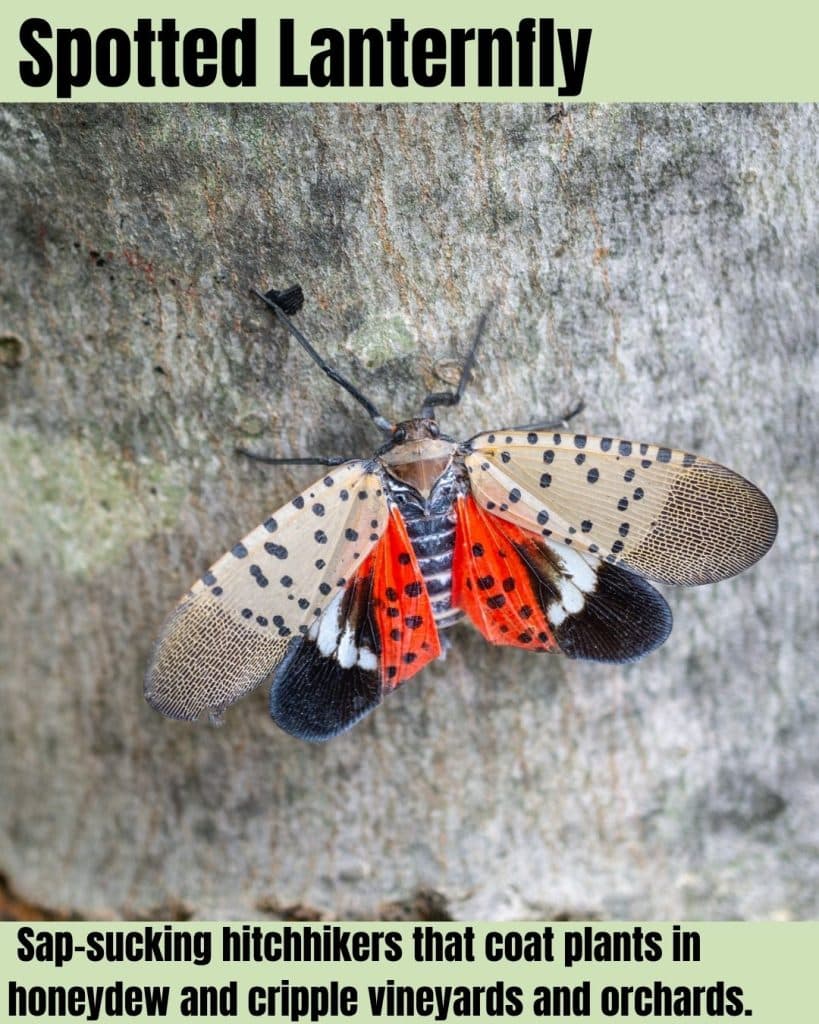
- Bright red hindwings flash when disturbed, nature’s own warning sign.
- Can jump a full foot, gliding from plant to plant with ease.
- Excretes sticky “honeydew” that fuels mold growth and gunk-coating everywhere.
Detected in Pennsylvania in 2014 via imported packing materials. This planthopper, native to China and Vietnam now invades Mid‐Atlantic states.
It feeds on sap from grapes, fruit trees, and hardwoods, excreting honeydew that fosters sooty mold.
Control involves scraping egg masses, sticky bands on trunks, and insecticide applications in hotspot areas.
20. Brown Marmorated Stink Bug (Halyomorpha halys)
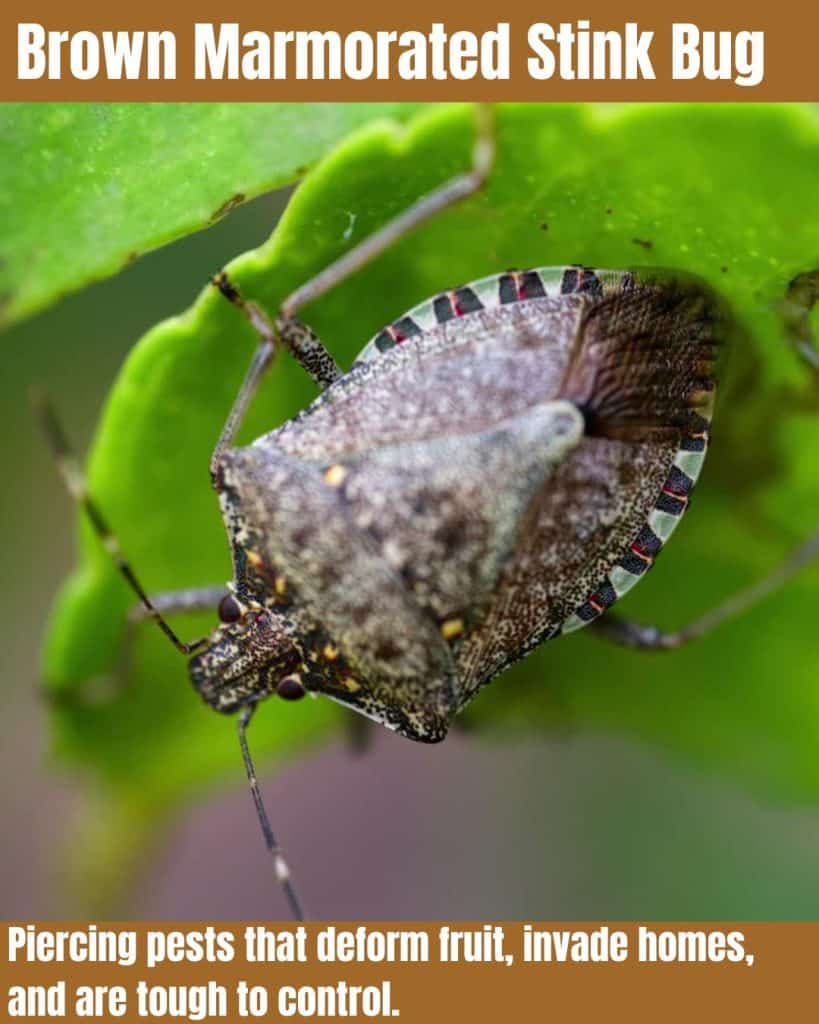
- Releases a scent so foul it’s earned the nickname “stink bug.”
- Can survive freezing temperatures by entering a state of dormancy.
- Has a protective armor-like shell that makes chemical control tricky.
First found in Pennsylvania in the early 2000s in shipping crates from East Asia, these stink bugs now plague homes and crops in over 40 states.
They pierce fruit and vegetables, causing sunken spots and deformities; control relies on sealing entry points, pheromone traps in orchards, and timely insecticide sprays.
21. Gypsy Moth (Lymantria dispar)
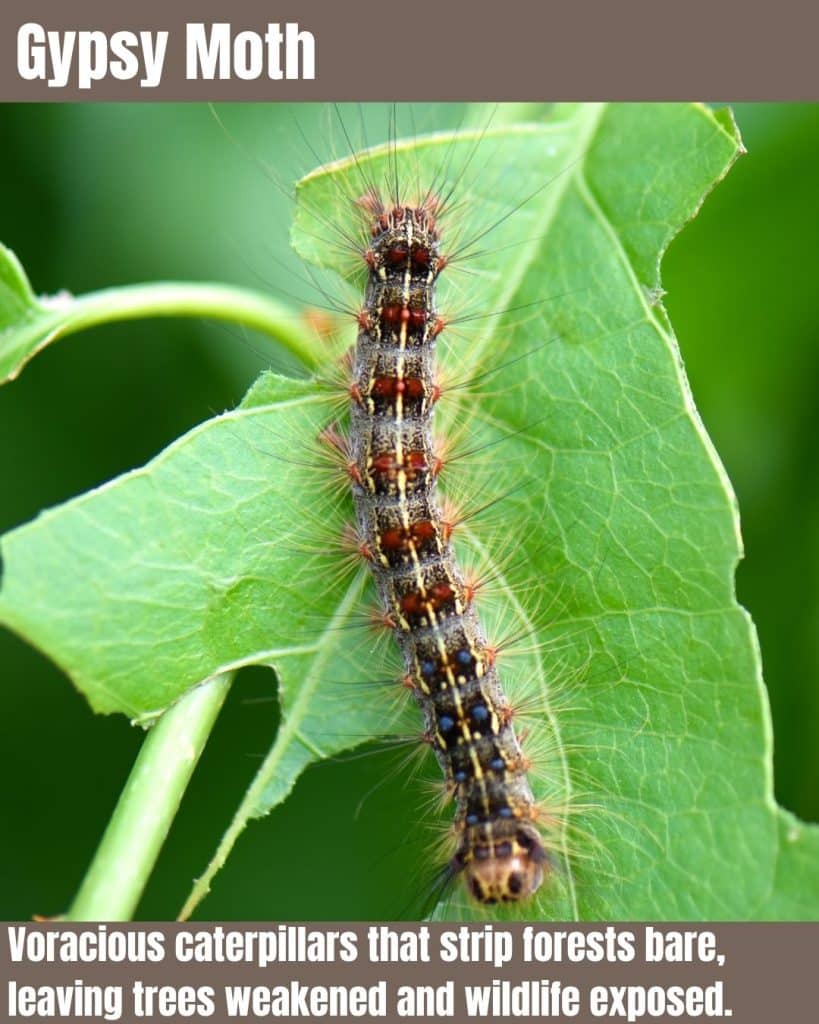
- Caterpillars can crawl half a mile in their short larval stage.
- Larvae are covered in irritating hairs that can cause rashes in people.
- Use silk “balloons” to disperse, wind carries them to new trees.
Released in Massachusetts in 1869 to start a silkworm venture, gypsy moth caterpillars now defoliate millions of acres of hardwood forests in the Northeast and Midwest each year.
Repeated defoliation stresses trees and increases their vulnerability to disease and fire; management uses pheromone disruption, microbial insecticides like Bacillus thuringiensis (Bt), and fungal pathogens.
22. Formosan Subterranean Termite (Coptotermes formosanus)
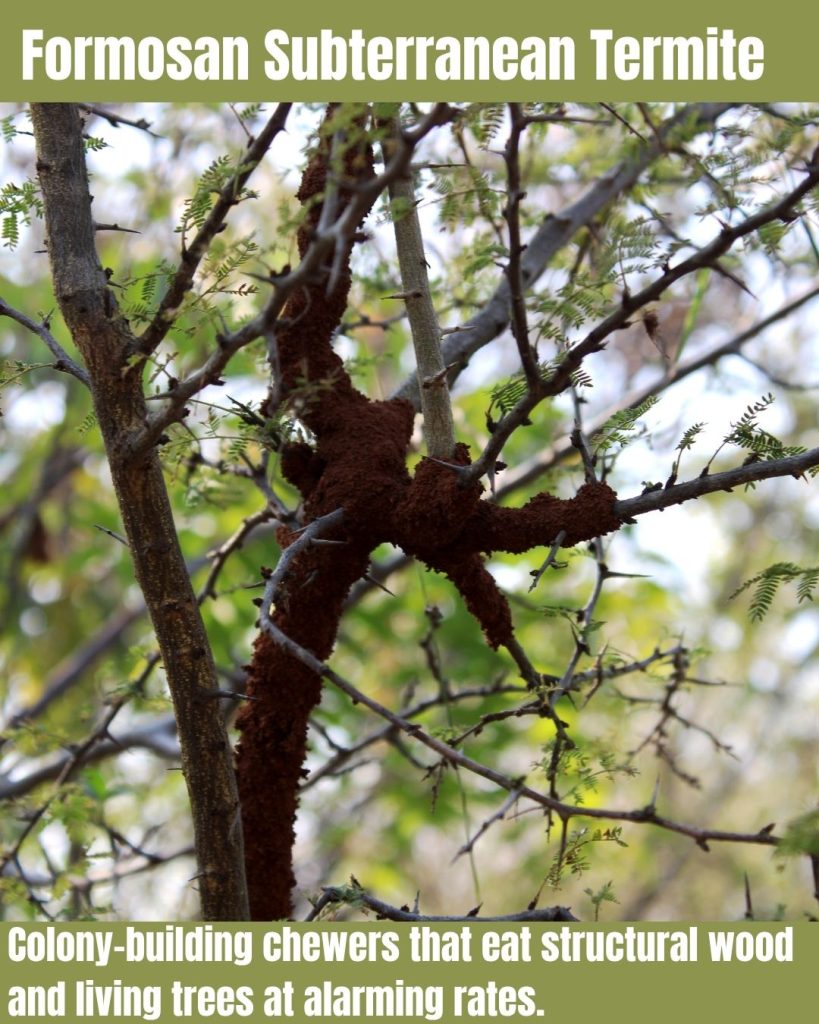
- Colonies can exceed two million individuals, creating living super-structures.
- Can consume a pound of wood per colony per day, they’re structural nightmares.
- Unusually aggressive swarmers invade homes en masse in spring.
First recorded in the U.S. in the 1960s in Louisiana after escaping cargo shipments from East Asia, Formosan termites build massive colonies underground.
They consume wood much faster than native species and threaten structures and utility poles across the Southeast.
Control includes baiting systems, soil-applied termiticides, and building exclusion barriers.s
23. Rusty Crayfish (Faxonius rusticus)
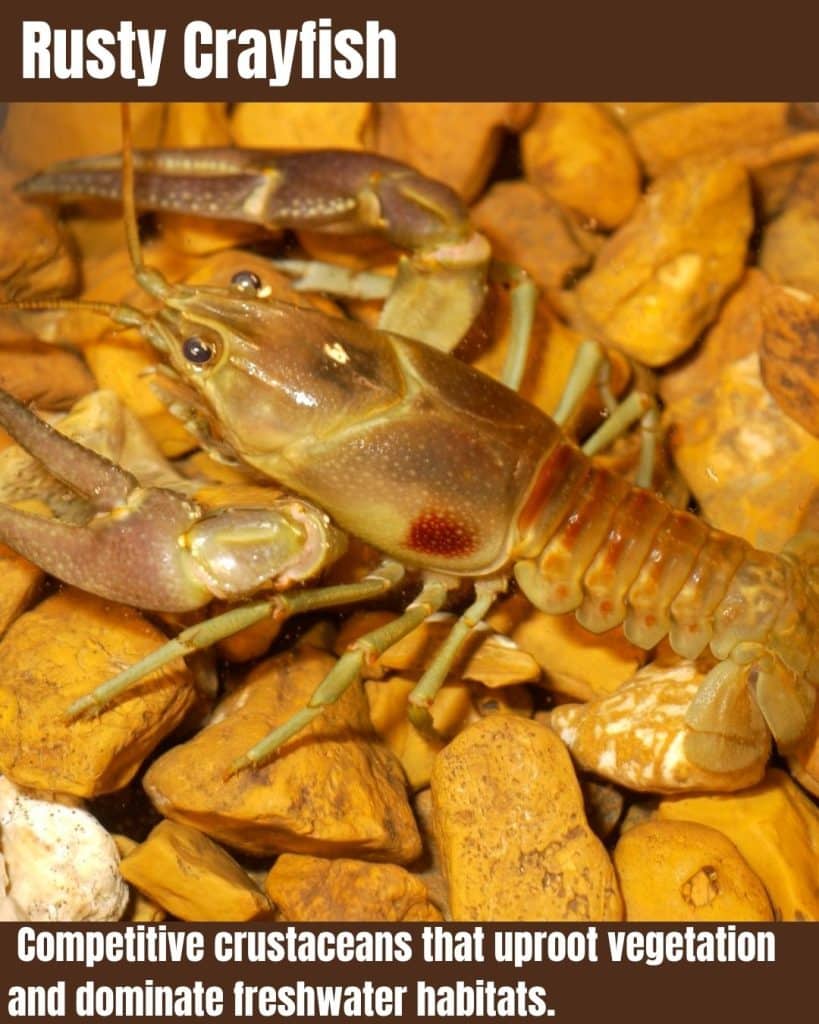
- Clips off limbs to distract predators, then regrows them later!
- Uproot aquatic plants to feed, turning clear water into algae blooms.
- Detect prey vibrations up to 10 cm away with specialized hairs.
Native to the Ohio River Basin, rusty crayfish were introduced to northern lakes for bait use in the 1960s.
They outcompete native crayfish, uproot aquatic vegetation, and alter fish habitat in Midwestern and Northeastern waterways.
Control involves trapping with baited traps, hand removal, and public education to prevent live release.
24. Asian Swamp Eel (Monopterus albus)
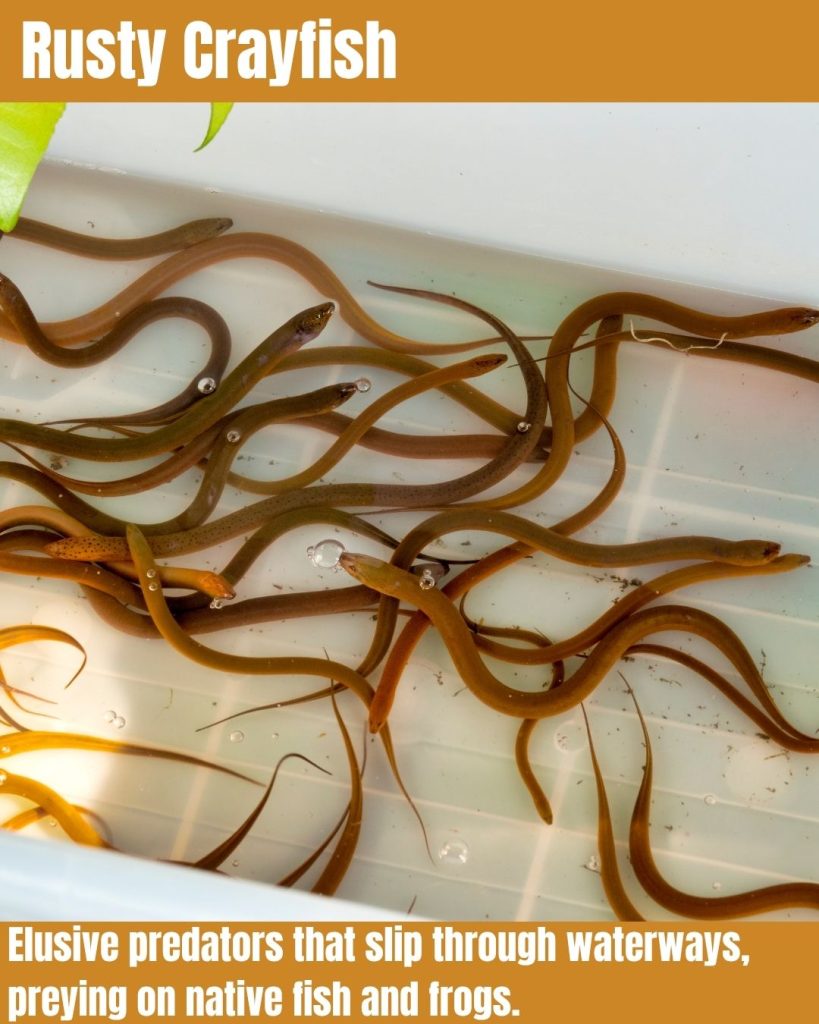
Slender, snakelike body allows them to burrow in mud during droughts.
Lacks pelvic fins, propels forward by undulating like a snake.
Known to prey on endangered frogs and turtles under the cover of night.
Hailing from South and Southeast Asia, swamp eels likely escaped from aquaculture tanks or bait buckets into Florida ponds mid-20th century.
As generalist predators of fish and crustaceans, they threaten wetland biodiversity in southern states; control includes draining infested ponds, hand removal, and barriers to block movement between water bodies.
25. Cane Toad (Rhinella marina)
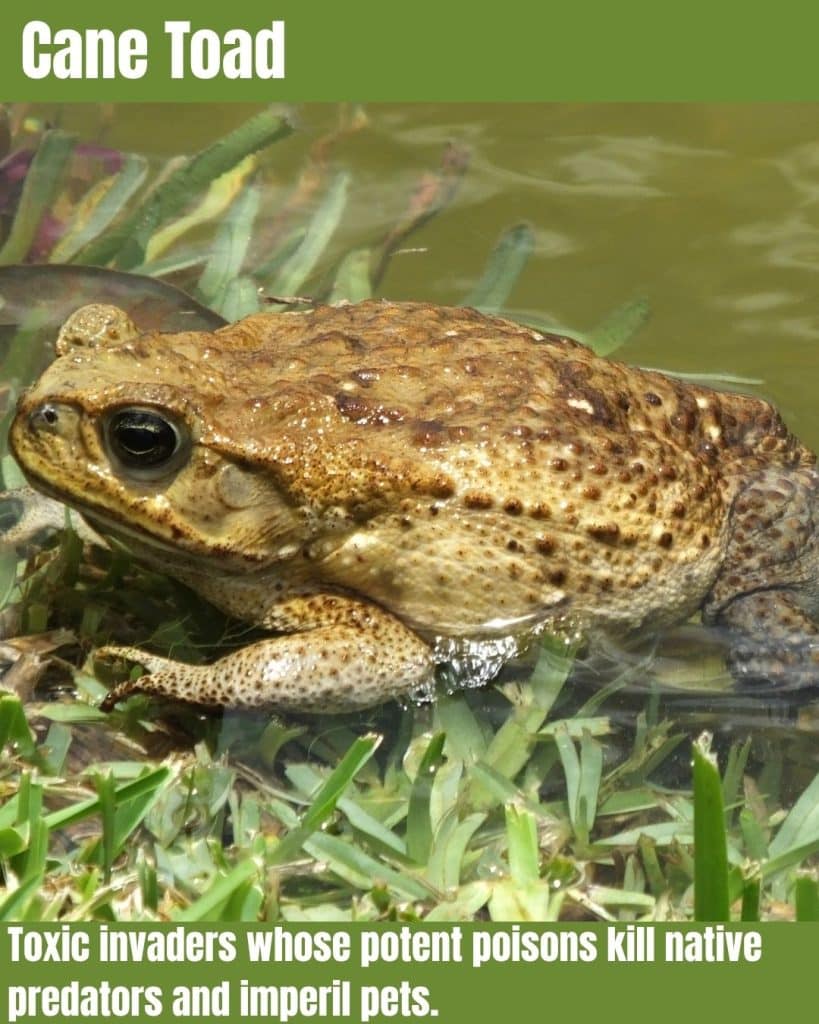
- Inflates its lungs to appear larger and deter predators.
- Can survive in arid zones by estivation, like hibernation, but for heat.
- Skin glands secrete bufotoxins potent enough to kill small mammals.
Imported from Central and South America to Hawaii in the 1930s for pest control- and occasionally released in Florida- cane toads secrete potent toxins that kill pets and native predators.
They breed prolifically in stagnant water and face no natural enemies; control strategies include hand-capture, intensive trapping, and public campaigns to prevent further introductions.